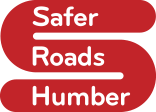Road Safety
The majority of advice in this section has been taken from the Think! road safety website and we acknowledge any copyright.
Drink driving
There is no excuse for drink driving. Any amount of alcohol affects your ability to judge speed and distance and slows down reaction times.
The effects can include:
- Slower reactions
- Increased stopping distance
- Poor judgement of speed and distance
- Reduced field of vision
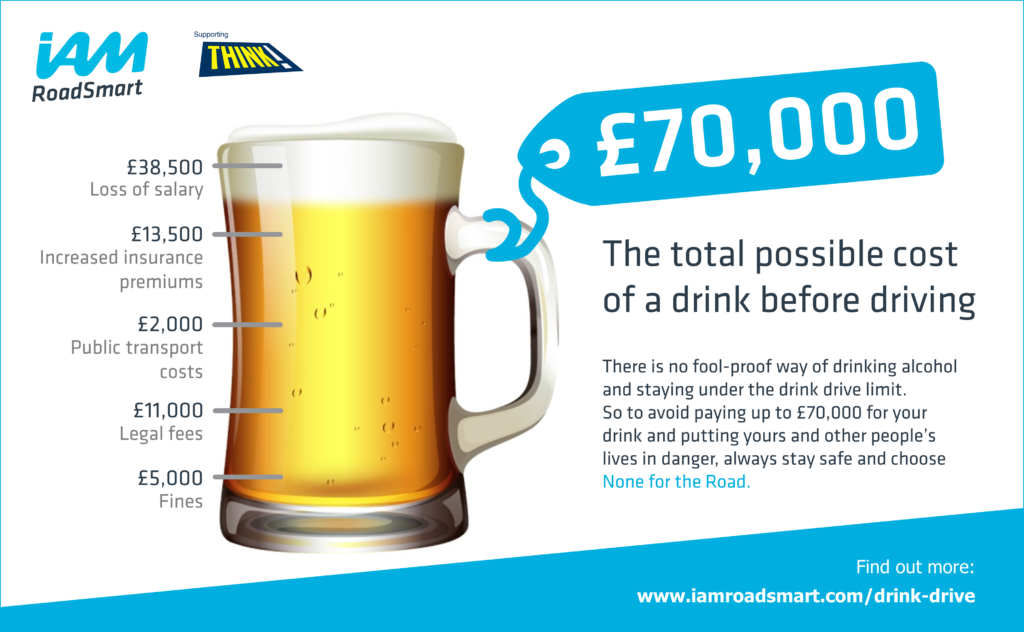
Alcohol also tends to make you feel over-confident and more likely to take risks when driving, which increases the danger to all road users, including yourself. If you drive at twice the current legal alcohol* limit, you are at least 50 times more likely to be involved in a fatal car crash compared to a driver who has not been drinking. There is no failsafe guide as to how to stay beneath the legal alcohol limit or how much you can drink and still drive safely.
*The legal alcohol limit for driving in England, Wales and Northern Ireland is 80 milligrammes of alcohol in 100 millilitres of blood. For Scotland the limit is 50 milligrammes of alcohol in 100 millilitres of blood.
It depends on:
- Your weight, sex, age, metabolism
- Stress levels
- An empty stomach
- The amount and type of alcohol
The only safe option is not to drink if you plan to drive. Never offer a drink to someone else who is driving.
If you plan to drink, don’t risk driving:
- Book a taxi
- Use public transport
- Stay overnight
- Arrange for someone who is not drinking to drive
- Don’t be tempted to get into a car with anyone else who has been drinking
You don’t have to be in a crash to be breathtested. The police can ask you to take a breath test if they suspect you have been drinking, or if you commit a traffic offence.
If you are convicted of drink driving you will:
- Lose your licence for 12 months (which could mean you lose your job);
- Face a maximum fine of £5,000;
- Face up to six months in prison; and
- Pay up to three times as much for car insurance.
The morning after
If you have been out drinking, you may still be affected by alcohol the next day. Even though you may feel OK when you get up, you may still be over the legal alcohol limit or unfit to drive, and could still lose your licence.
It is impossible to get rid of alcohol any faster. A shower, cup of coffee or other ways of ‘sobering up’ will not help. It just takes time. Visit Morning After for further information.
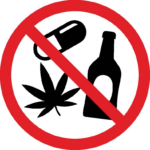 Drug driving
Drug driving
Around 18% of people killed in road crashes have traces of illegal drugs in their blood, with cannabis being the most common.
Drugs can affect a driver’s behaviour in a number of different ways, which include slower reaction time and poor concentration. The effects can last for hours or even days. Driving under the influence of drugs – whether prescribed medication or illegal substances – is just as dangerous as driving under the influence of alcohol. It is also against the law.
Here are just a few ways that drugs can affect your driving, which means that you aren’t able to drive safely:
- Slower reaction times
- Poor concentration
- Confused thinking
- Over confidence, so you take unnecessary risks
- Impaired co-ordination
- Erratic behaviour
- Hallucinations
- Blurred vision/enlarged pupils
- Panic attacks and paranoia
- Tremors
- Dizziness
The police can carry out roadside swab tests to help them decide whether to arrest you if they think you are unfit to drive through drugs. The penalties are the same as for drink driving. You could face a minimum one-year driving ban, a fine of up to £5,000 and six months imprisonment.
If you need further information and advice about the effects of drugs, visit the Talk to Frank website.
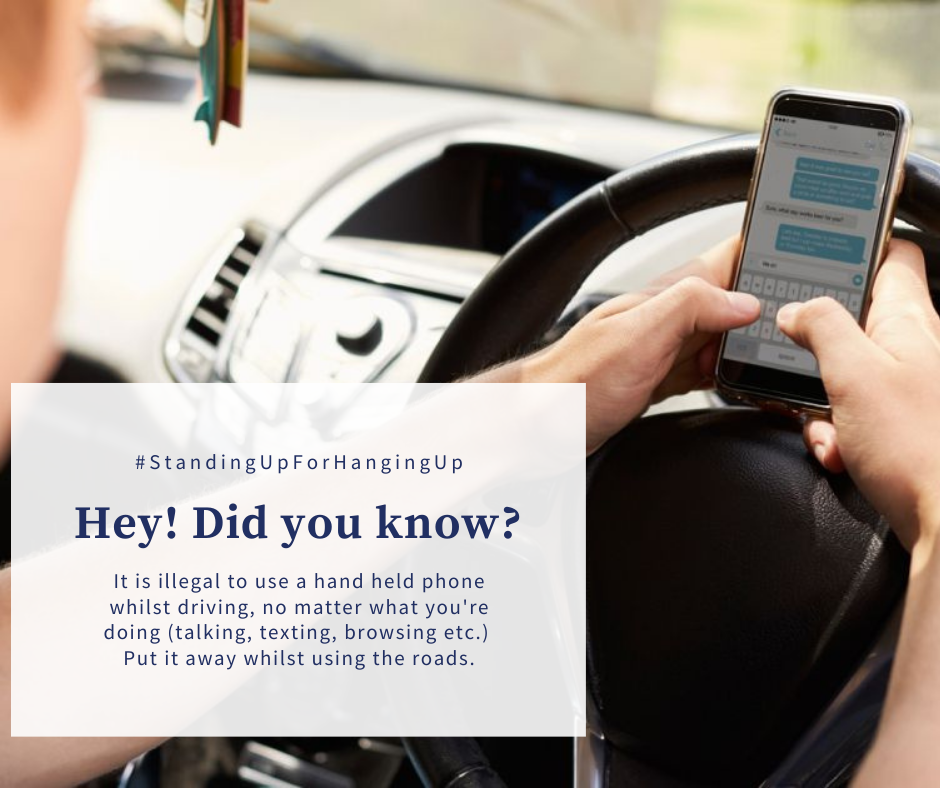 Mobile phones
Mobile phones
It is illegal to use a hand-held mobile phone when you are driving, even when you have stopped at traffic lights or are in a queue of traffic.
In 2017, new legalisation came into force which increased the fine from £100 to £200, with six points being added to your driver’s licence. If you get six points within two years of passing your test, your licence will be revoked and you will have to re-sit your test.
The law includes making or receiving calls, pictures, text messaging or accessing the internet. To use your device, you must pull over to a safe location and switch off the engine. You can also be prosecuted for using a hands-free mobile phone if you fail to have proper control of your vehicle. The only exceptions to the rule are when you need to call 999 or 112 in response to a genuine emergency. Two-way radios are not covered by this offence, but other devices for sending or receiving data are included if they are held while driving i.e. a PDA, Blackberry or similar device.
Don’t Drive Tired
One in five road accidents on motorways and other monotonous roads are caused by someone falling asleep at the wheel, mostly involving running off the road or into the back of another vehicle. Sleep-related crashes are particularly dangerous and likely to result in serious injury because the driver won’t have woken in time to brake before impact.
You may find yourself fighting sleep in a warm car by winding down the window or turning up the radio, but you might still nod off for a couple of seconds. If you are doing 70mph on a motorway, you will have travelled an eighth of a mile in that time.
Body clock
Your body clock winds down at certain times, so driving between midnight and 6am, or 2pm to 4pm is particularly risky. Men under 30 are most likely to fall asleep at the wheel, especially in the early hours of the morning. Motorists need to be aware of the risks of driving for too long or when they are tired and should plan their journey so they don’t reach that stage.
Top Tips
- Plan your journey to include a 15-minute break every two hours.
- Find a safe place to stop if you feel drowsy – not the hard shoulder.
- Drink two cups of coffee or a high-caffeine drink, then take a short nap to allow the caffeine to kick in.
- Don’t start a long trip if you are already tired.
- Remember the risks if you have to get up unusually early to start a long drive.
- Try to avoid long trips between midnight and 6am when you are likely to feel sleepy anyway.
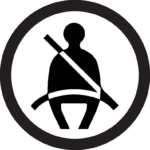 Seatbelts and car seats
Seatbelts and car seats
For your own and others’ safety, the law requires you to use a seatbelt if one is fitted.
Seatbelt wearing in the front seat saves over 2,200 lives every year. Everyone knows they should wear a seatbelt in the front seat, but many people still don’t realise how dangerous it is not to wear a seatbelt in the back. In a crash at 30mph, if you are unrestrained, you will hit the front seat, and anyone in it, with a force of between 30 and 60 times your own body weight.
Such an impact could result in death or serious injury to both yourself and front seat occupants. Any award for damages following an accident may be reduced if you were not wearing a seatbelt.
For further information about seatbelts and car seats, please visit Good Egg Car Safety.
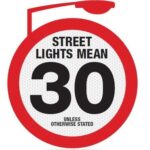 Speed limits
Speed limits
The speed limit for any road is the maximum speed a vehicle should be travelling at. You should always drive safely and appropriately within the speed limit at all times.
30mph zones
All urban roads in this country are subject to a 30mph speed limit unless there are signs to tell you a higher or lower limit applies. If you cannot see a sign on an urban road, you must always assume that the speed limit is 30mph. If there are streetlights along the road, again the speed limit is usually 30mph unless signs tell you differently. Visit the Department for Transport website for further information.
| Built up area | Single Carriageway | Dual Carriageway | Motorway | |
| Cars and motorcycles | 30 | 60 | 70 | 70 |
| Cars towing caravans or trailers | 30 | 50 | 60 | 60 |
| Buses or coaches | 30 | 50 | 60 | 70 |
| Goods vehicles <7.5tonnes | 30 | 50 | 60 | 60* |
| Goods vehicles >7.5 tonnes | 30 | 50 | 60 | 60 |
*If not articulated or towing the maximum speed is 70mph
Road users
We are all road users, be it as pedestrian, cyclist, horse rider, driver or motorcyclist, and we are all exposed to the risk of using our roads. This is why road safety should be of interest to all of us. This section gives some specific advice to different groups of road users.
Drivers
As a driver of a vehicle it is your legal duty to ensure that you obey the rules of the road and you must hold a valid driver’s licence. You must have adequate insurance whether driving your own or another person’s vehicle. It is also your duty to inform your insurance company of any points you may have on your licence, as this could invalidate your insurance cover.
Registered Keeper
If you are the registered owner/ keeper of the car, it is your legal duty to ensure that your vehicle is roadworthy, adequately insured and taxed and that your details are up to date with the Driver and Vehicle Licensing Agency (DVLA). It is also your duty to ensure anyone who you allow to drive your vehicle is adequately insured and holds a valid driver’s licence.
Young drivers
If you have just passed your driving test – congratulations!
However, 16 to 24 year olds are disproportionately represented in our killed or seriously injured (KSI) casualty statistics. They currently make up only 11% of the Humber population and only 7% of full driving license holders nationally, but account for 23% of all killed or seriously injured casualties. One in five newly qualified drivers has a crash within a year. However, the accident liability is reduced by nearly half after two years of driving experience.
Remember: newly qualified drivers are still on “probation” for a period of two years, but if you clock up six points or more during this period, you will lose your licence and revert to learner status again. Drivers have to retake both the theory and practical parts of the test.
The main penalty point offences are:
- Using a hand held mobile phone whilst driving: 6 points
- Speeding: 3-6 points
- Going through a red light: 3 points
- Careless driving: 3-9 points
- Driving without insurance: 6-8 points
- Failing to stop after an accident: 5-10 points
If you have six or more penalty points, you will get a letter telling you your licence is no longer valid. You should inform your insurance company immediately. You will have to apply for a new provisional licence to continue driving as a learner.
Remember, as a learner:
- You cannot drive on the motorway
- You must display L plates
- You cannot drive a car unless you are accompanied by someone over 21 who has had a full driving licence for at least three years
- You are limited to less powerful motorbikes
Older drivers
Older drivers have more experience. They are also likely to be more tolerant and confident too, which can mean they are safer on the road than other age groups.
But your sight, hearing and judgement may not be as sharp as they were. And driving is more complex and demanding than it used to be, with more traffic on the roads.
You need to take even greater care and adjust your driving habits to compensate for any deterioration in your eyesight or judgement. A simple adaptation to your car may help if you have mobility problems.
Medical conditions
You must notify the Driver and Vehicle Licensing Agency (DVLA) of the onset or worsening of a medical condition that could affect your ability to drive safely, including heart problems, epilepsy and diabetes. If you are on prescribed medication, ask your doctor if it could affect your driving.
Your eyesight
It is illegal to drive if you cannot read a number plate from 20.5m (67 feet) away. Have your eyes tested regularly, as changes in your eyesight can happen slowly and without you realising it.
Refresh your skills
Even experienced drivers can slip into bad habits, so it is a good idea to refresh your knowledge from time to time and keep up-to-date with changes in the law.
Renewing your licence
You must renew your licence when you reach the age of 70 and every three years afterwards. But there is no legal cut-off age when you should stop driving – it is really up to you. It won’t be an easy decision to make but don’t wait for an accident to convince you it is time to stop.
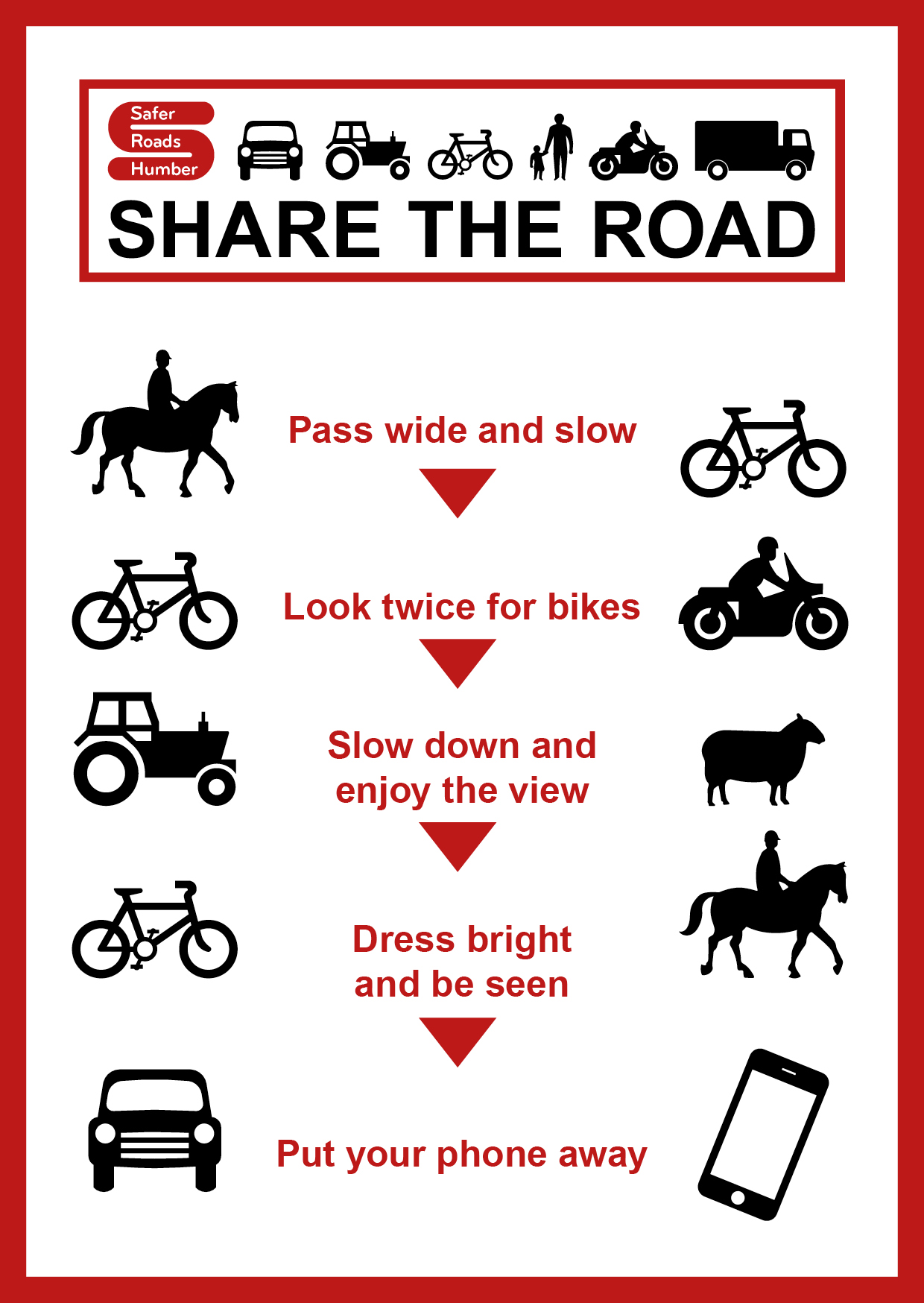
Walking
For many people, walking is their main transport for journeys under a mile. It is a healthy option and can be enjoyable and fun. Some people use their walking time as ‘me time’. It is recommended that adults do 30 minutes a day of moderate intensity physical activity at least five times a week. Walking or cycling your short daily trips could achieve this target and give you a range of health benefits.
However, you still need to keep yourself safe whilst walking around the region.
Top tips
- Wear comfortable clothing and flat, well-fitting shoes. You may want to keep a “posh” pair of shoes at work to change into and wear a pair of trainers to walk in.
- Ensure the route you use is well lit and well used at the times you are walking. Consider starting a walking group with people from work or from your neighbourhood.
- Stay on the footpaths if there is one provided.
- Use pedestrian crossings where possible – they are provided for your safety.
- Brighten yourself up – consider wearing bright coloured reflective clothes or carry a reflective bag. It may not be fashionable, but it helps drivers to spot you on dark nights.
- Don’t use headphones whilst walking – be alert and listen out for traffic while crossing the road.
- Don’t use your mobile phone – texting or talking on the phone draws your attention away from walking. You risk bumping into other pedestrians or obstacles and risk being involved in a crash when crossing the road.
- On rural roads without footpaths, walk facing the oncoming traffic, in single file.
- Closely supervise any children or pets walking with you.
- Ensure that children understand that roads can be dangerous places and that they need to keep close to adults.
- In warmer weather, remember to take a drink with you and drink from it regularly.
- Be sure to get advice from your doctor before increasing your exercise if you haven’t done any for a while or if you have a medical history that is a cause for concern.
- Do build your walking up gradually if you haven’t been active for a while. Build up the distance and walking pace over time.
- Expect the unexpected! Don’t automatically think that a driver has seen you.
 Cycling
Cycling
People cycle for a whole range of reasons. It could be that it is the quickest and cheapest way for you to travel around the region, you may use your bike to keep fit, to be greener, it could be your main form of transport or just for the sheer fun of it.
Whatever the reason is that makes you get on your bike, make sure that you keep yourself safe. Always:
- Wear a cycle helmet.
- Wear appropriate clothing for cycling. Avoid clothes which may get tangled in the chain or in a wheel or may obscure your lights.
- Wear light-coloured or fluorescent clothing which helps other road users to see you in daylight and poor light.
- Wear reflective clothing and / or accessories (vest, belt, arm or ankle bands) in the dark. At night your cycle MUST have white front and red rear lights lit.
For further information about cycling safely in our region visit Ride the Routes.
Motorcycling
Anyone who rides a motorcycle or scooter knows that they can be the fastest way from A to B. Riding them is also exhilarating and the word is getting around – more and more people are taking up motorcycling. But with traffic conditions these days, it is more important than ever that you can deal with the unexpected.
If you are already good, make yourself better. The best motorcyclists ride defensively so they are less likely to have accidents. We all meet idiots on the roads and motorcyclists are vulnerable to their mistakes. Those with good defensive skills ride like they expect to meet one every second. They are in control, so they enjoy more relaxed riding.
Make sure you:
- Anticipate the actions of motorists.
- Are alert and observant this is important when you are negotiating junctions or roundabouts and when you need to look out for other vulnerable road users – children, pedestrians, cyclists and horse riders.
- Ride at a speed that will enable you to slow down and stop in good time. The unexpected can happen. And ride according to the conditions: slow down if it is wet, foggy or icy.
- Position yourself in the best place, usually the middle of the lane. But take up your road position in good time before turning right or left, showing others what you aim to do.
- Overtake safely. Can you see hazards? Is there a bend or a junction? Can you overtake without speeding up or swerving too much?
- Take a ‘lifesaver’ glance over your shoulder before carrying out manoeuvres when you need to know where other drivers are and what they are doing.
- Are seen. Dipped headlights, even in good daylight, can help you to be seen.
- Sometimes drivers will wind you up. But if you act aggressively you may have to pay the penalty. Count to 10 and congratulate yourself on your cool-headedness. And however tempted you are, don’t race on public roads. Save it for the race track.
Motorcycle safety checklist
- Helmet: Your most important piece of kit. Make sure the fit is snug and the helmet is in good condition. Keep the visor clean, carry a can of spray cleaner and a duster. If it is scratched, replace it. Check out the SHARP website which gives ratings of a wide range of helmet types, at a range of different prices.
- Clothing: You need boots, trousers, gloves and a jacket to keep you dry, warm and, should the worse happen, safe. These need to be made and designed for the purpose. You will get hot in the summer, but do not be tempted to ride without any of these items. Your local dealer will give you plenty of friendly help and advice.
- Tyres: Check air pressure and tread before every ride. Also check your tyres for potential dangers like nails.
- Fluids: Check fuel, oil, brake fluid and coolant (where applicable).
- Lights: Check brake lights, indicators, head and tail lights.
- Group Riding: Requires skill and practice to be done safely and must be done in a lawful manner. Set a suitable pace for the least experienced rider in the group. Develop a system which allows the group to stay together. Arrange frequent places to stop and get together to check everyone is OK. If someone in your group drives dangerously and puts the group or themselves at risk, tell them. It is no point wishing you had when it has all gone wrong.
Horse Rider
Coming soon
